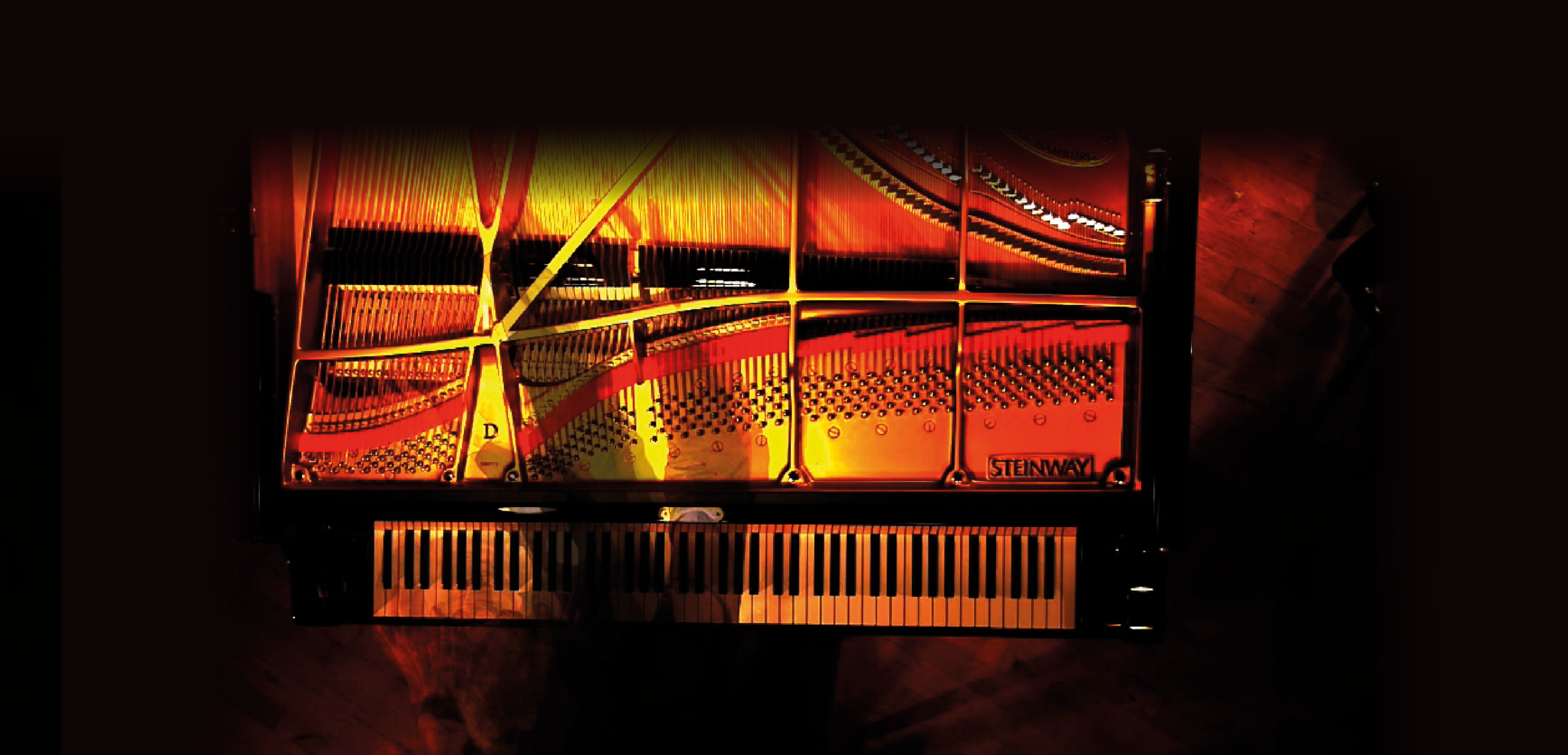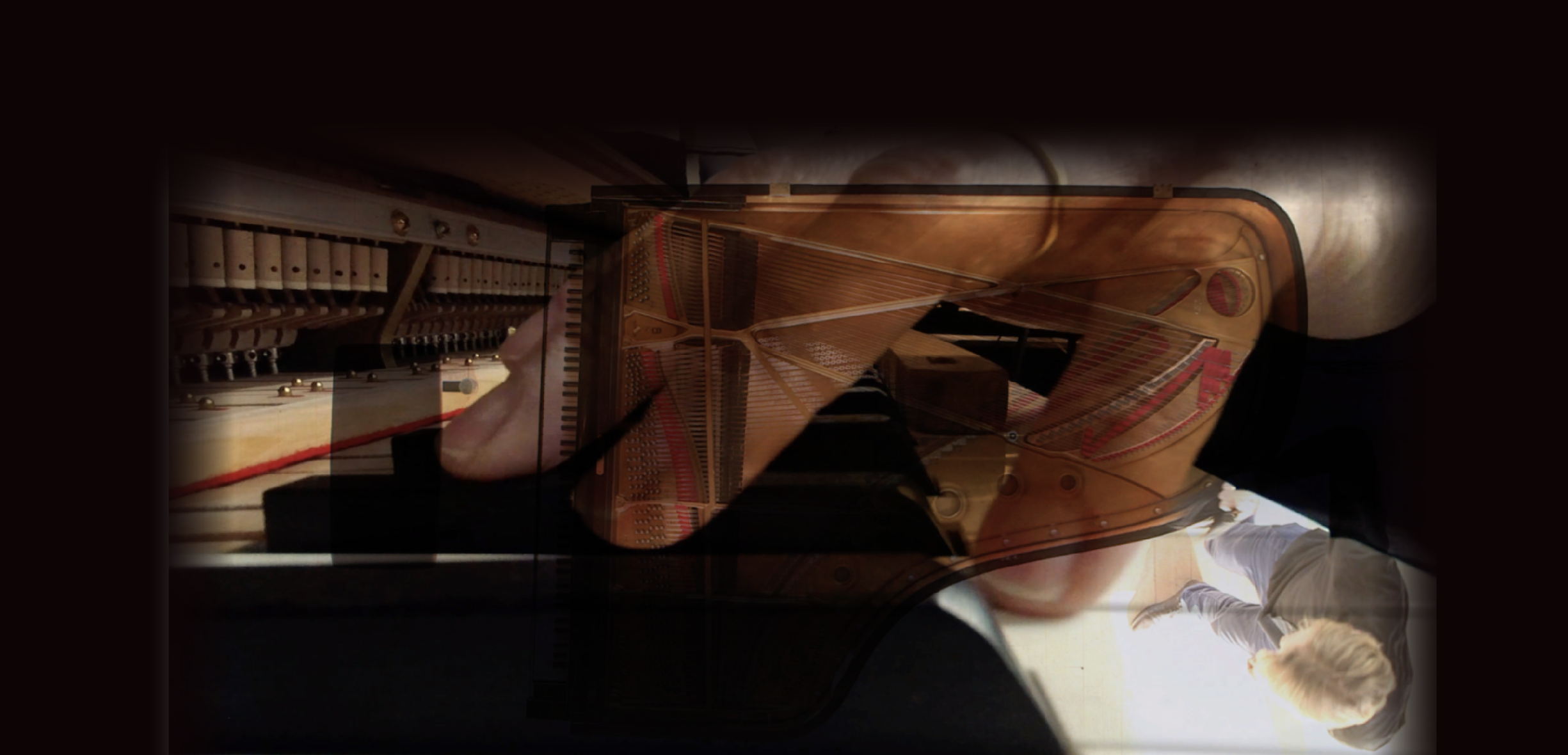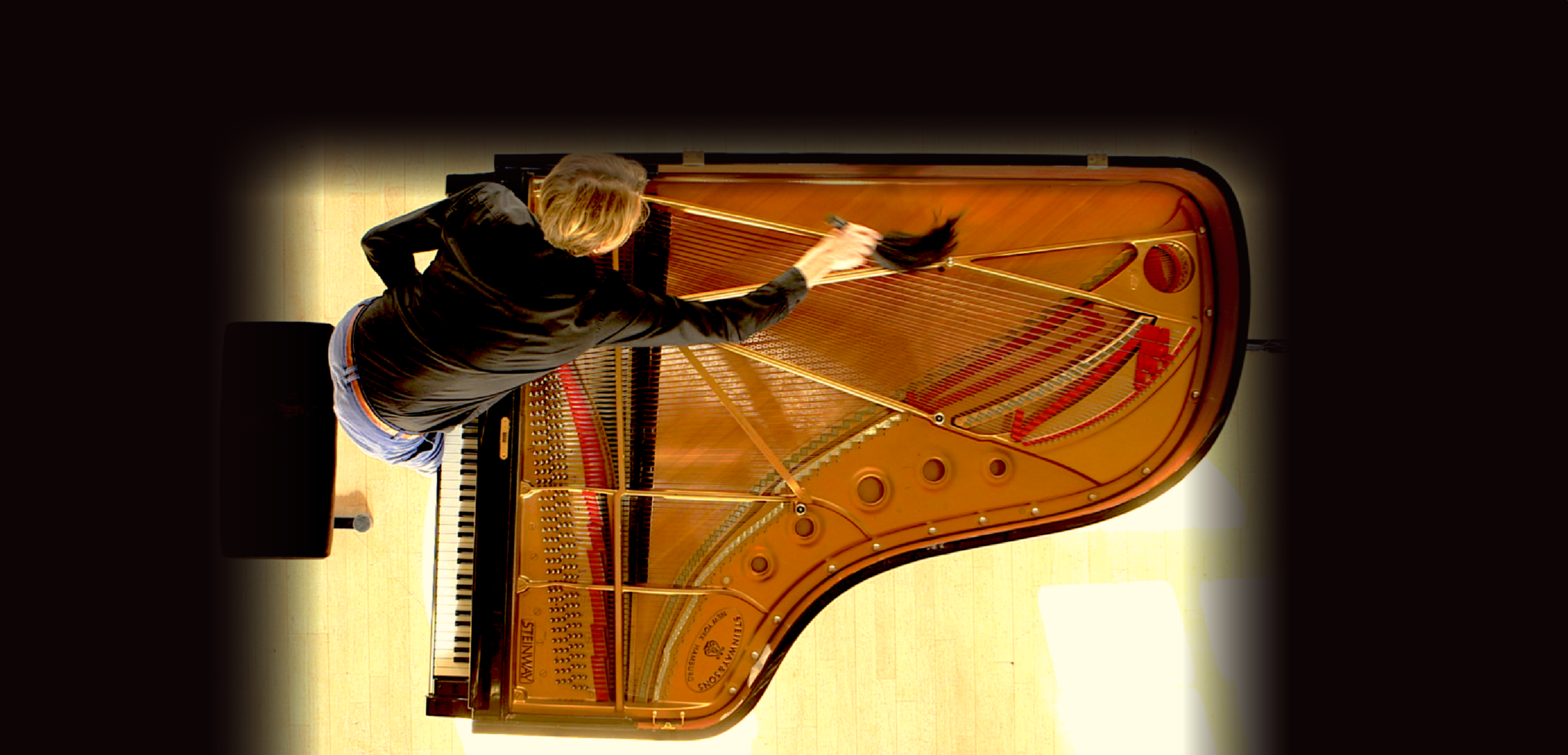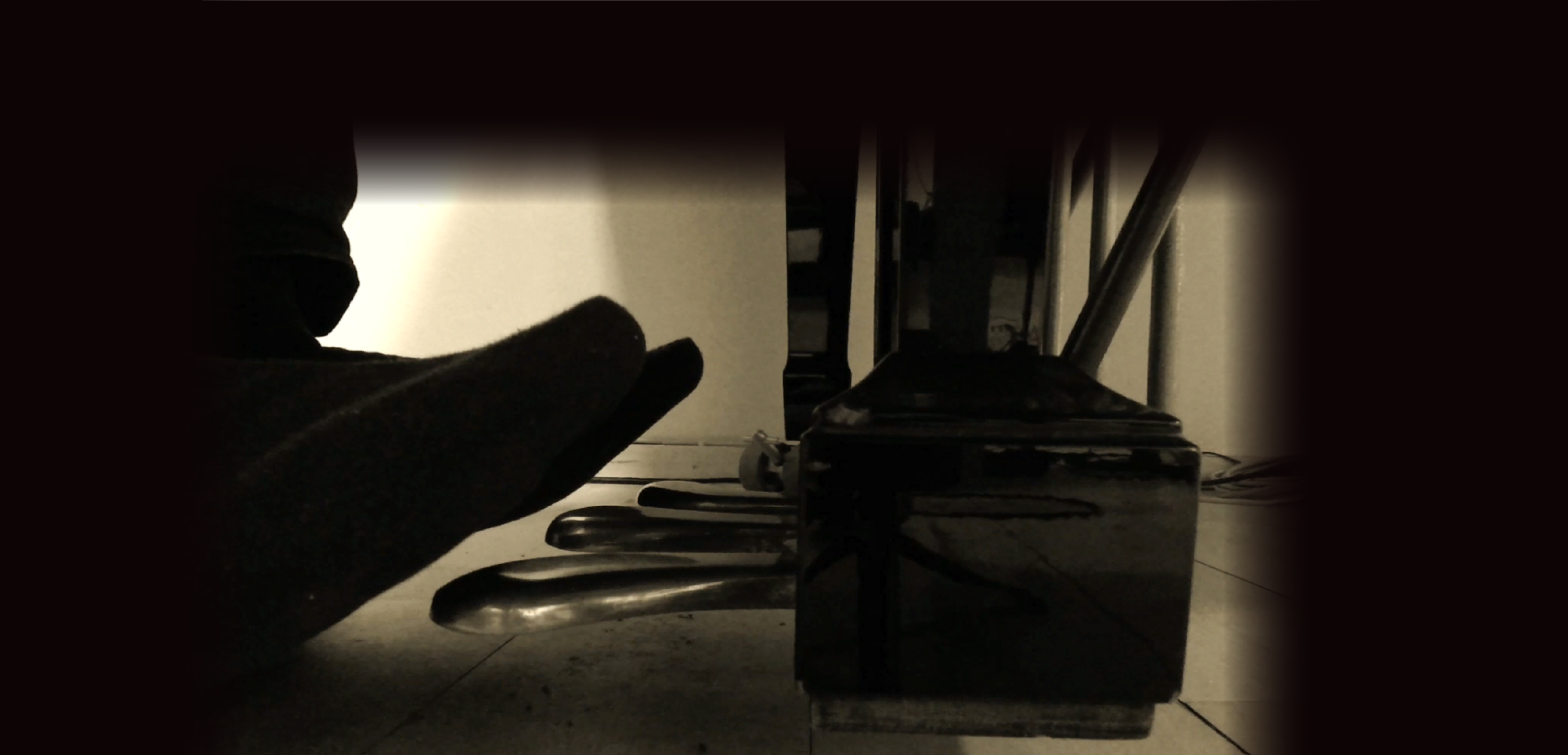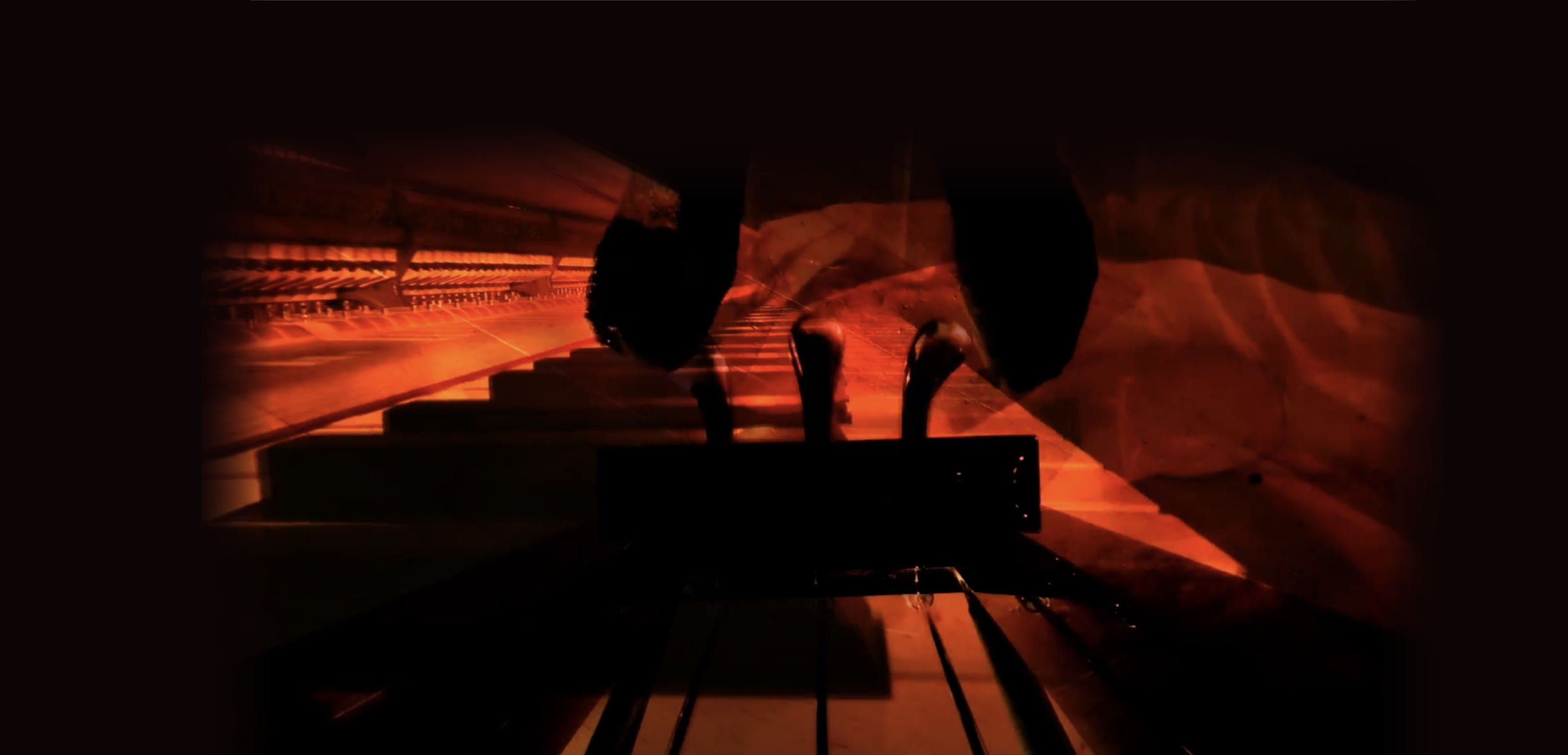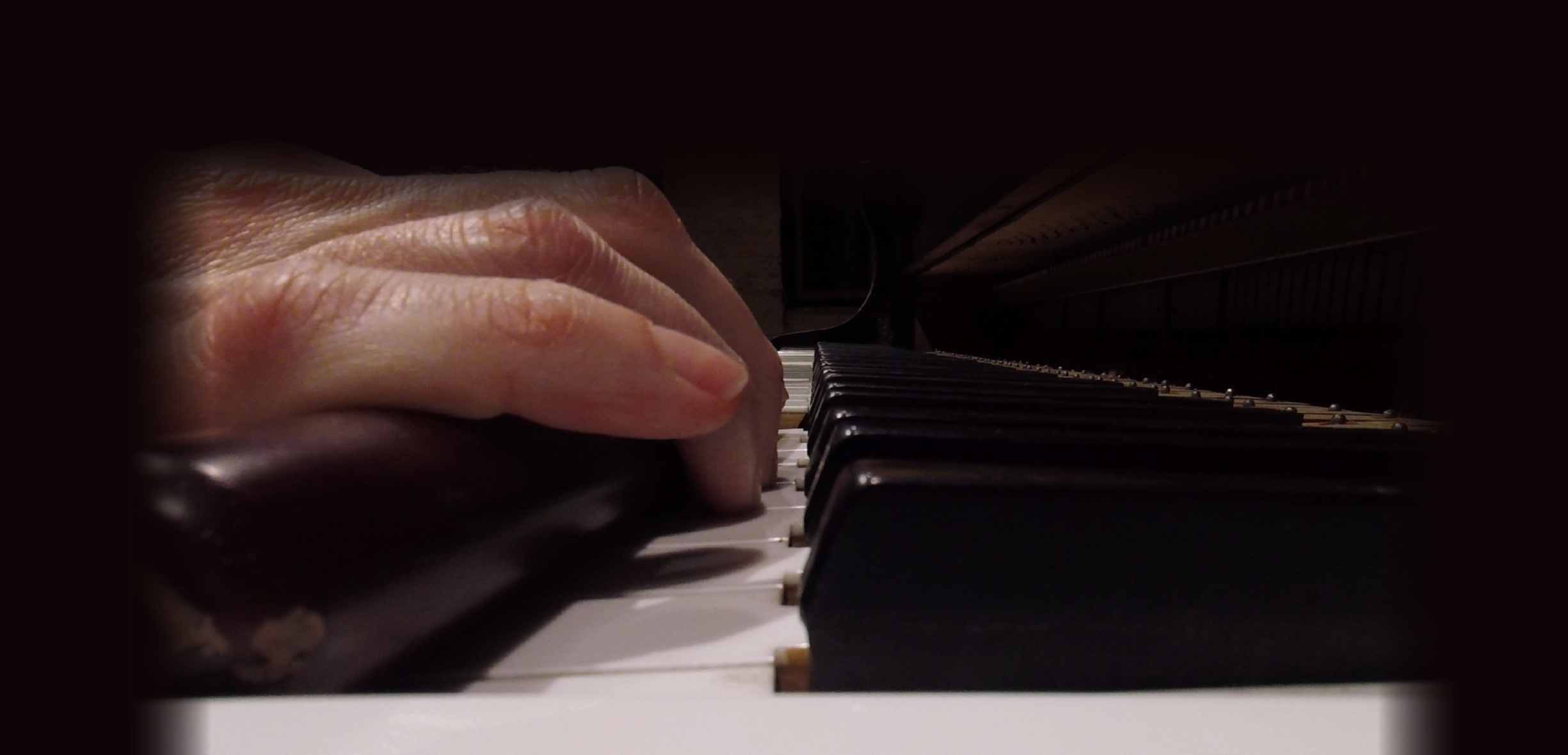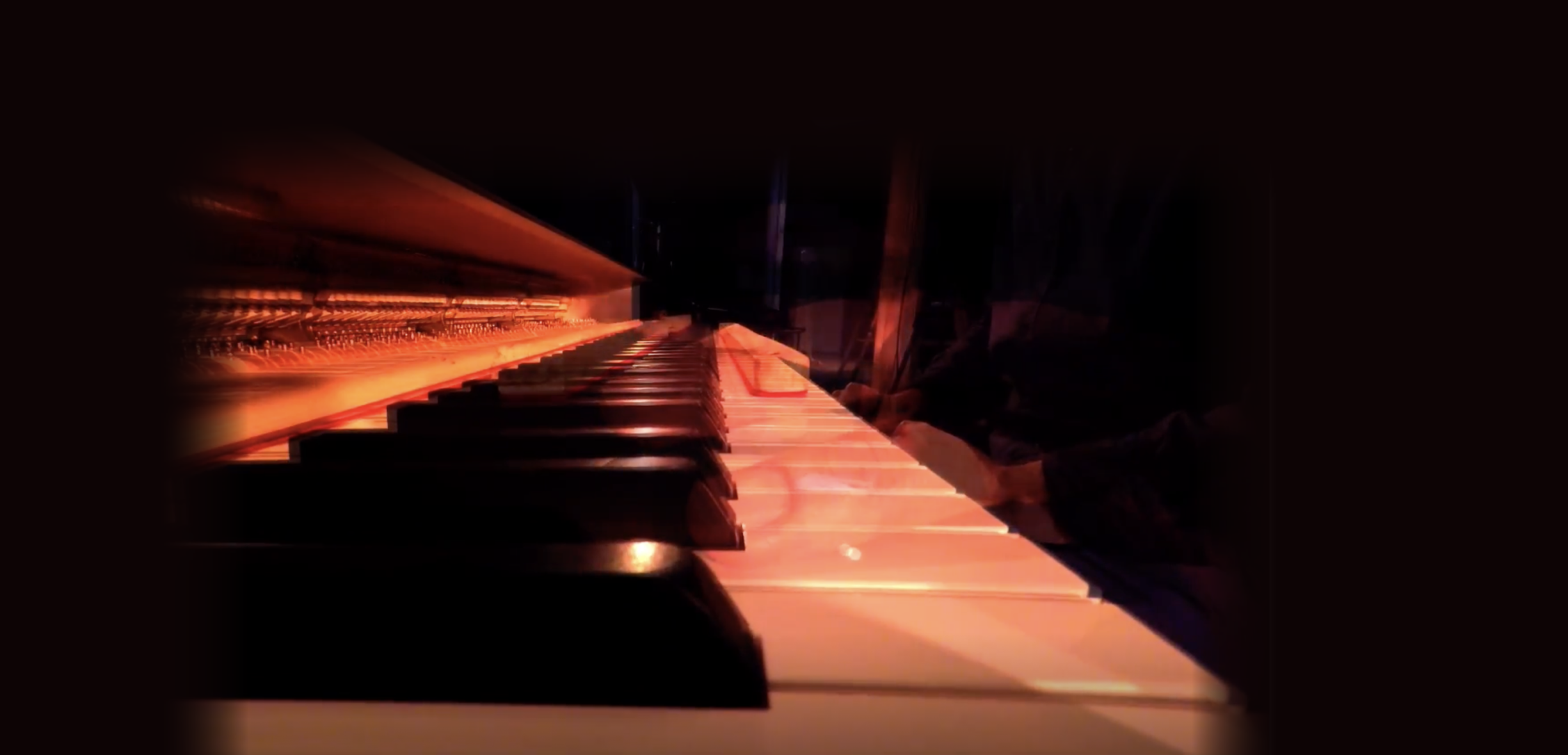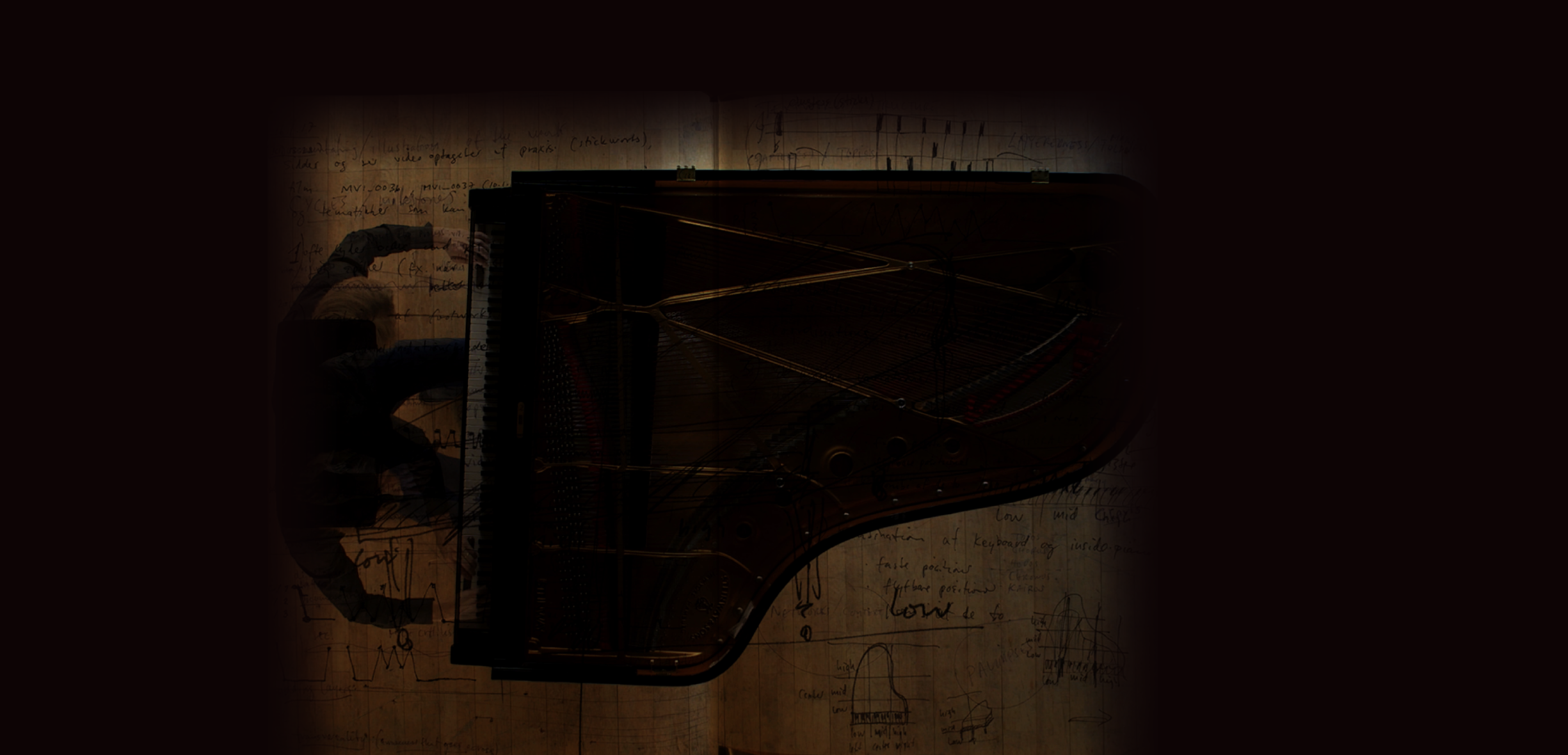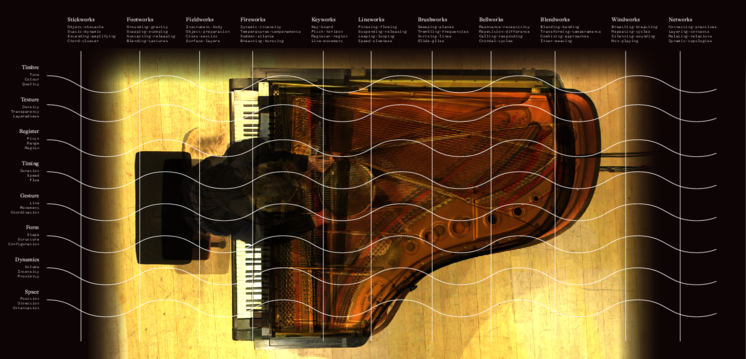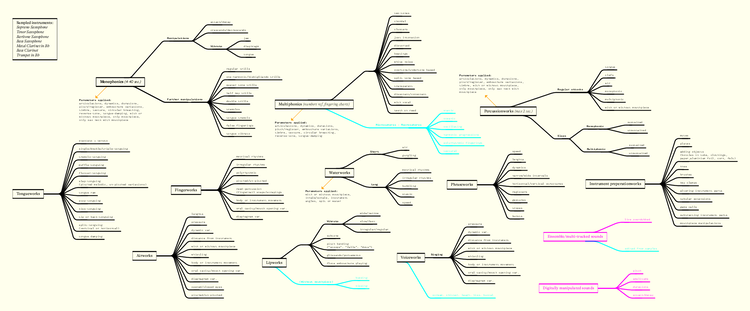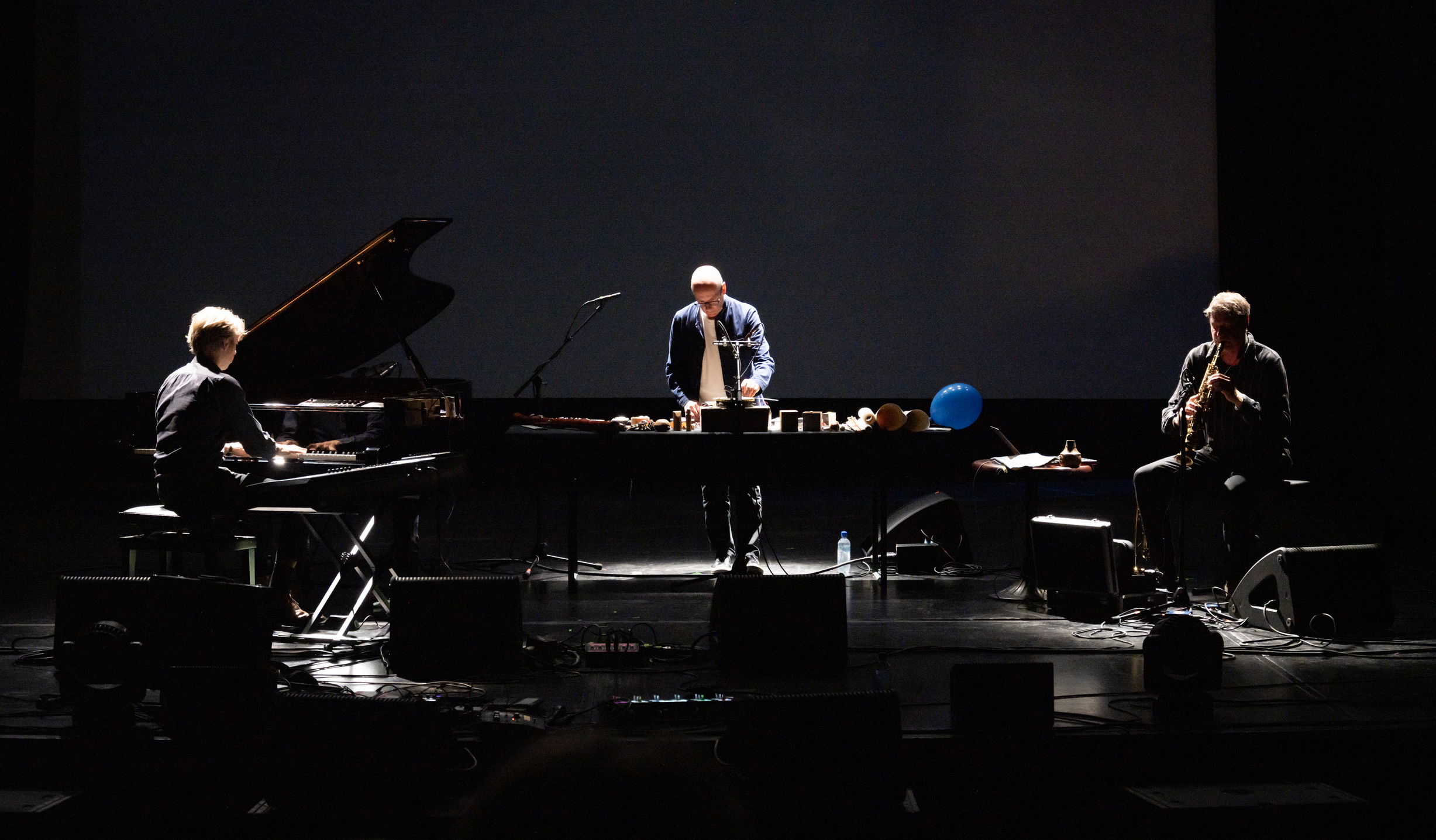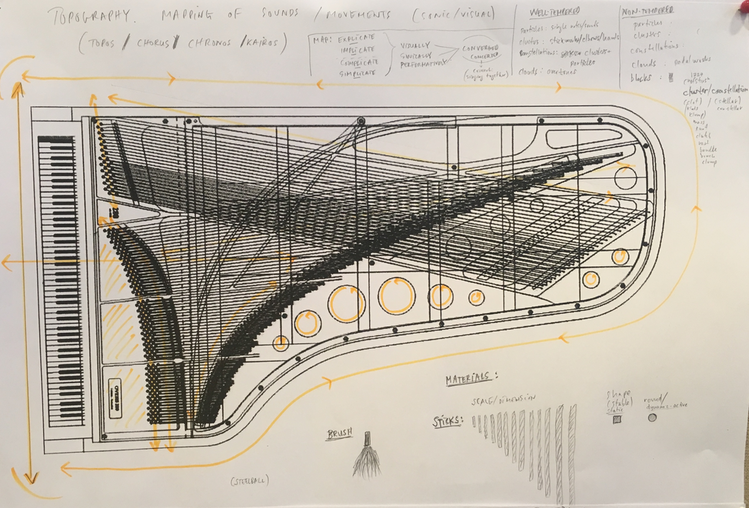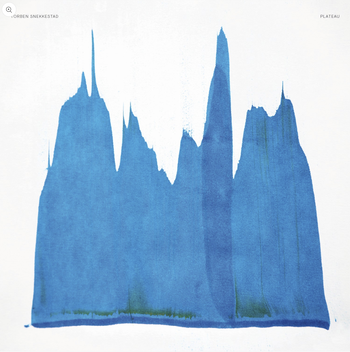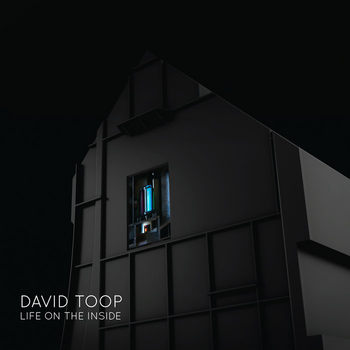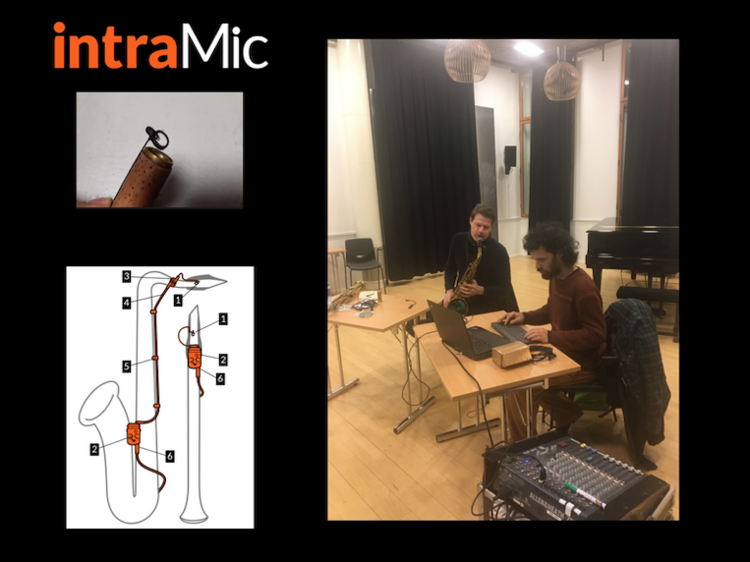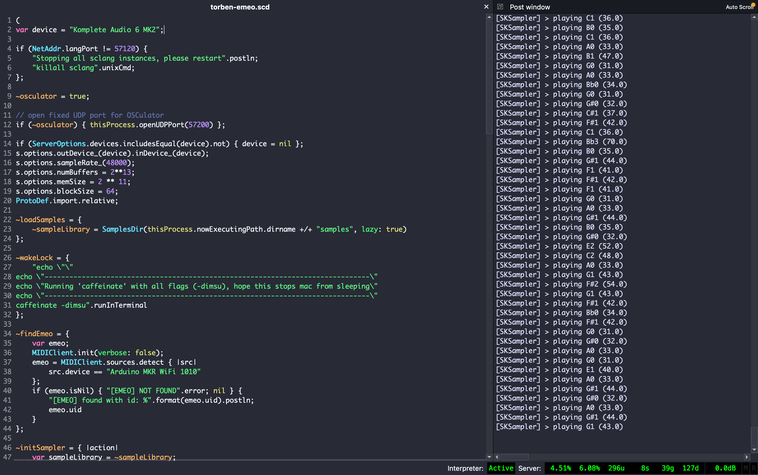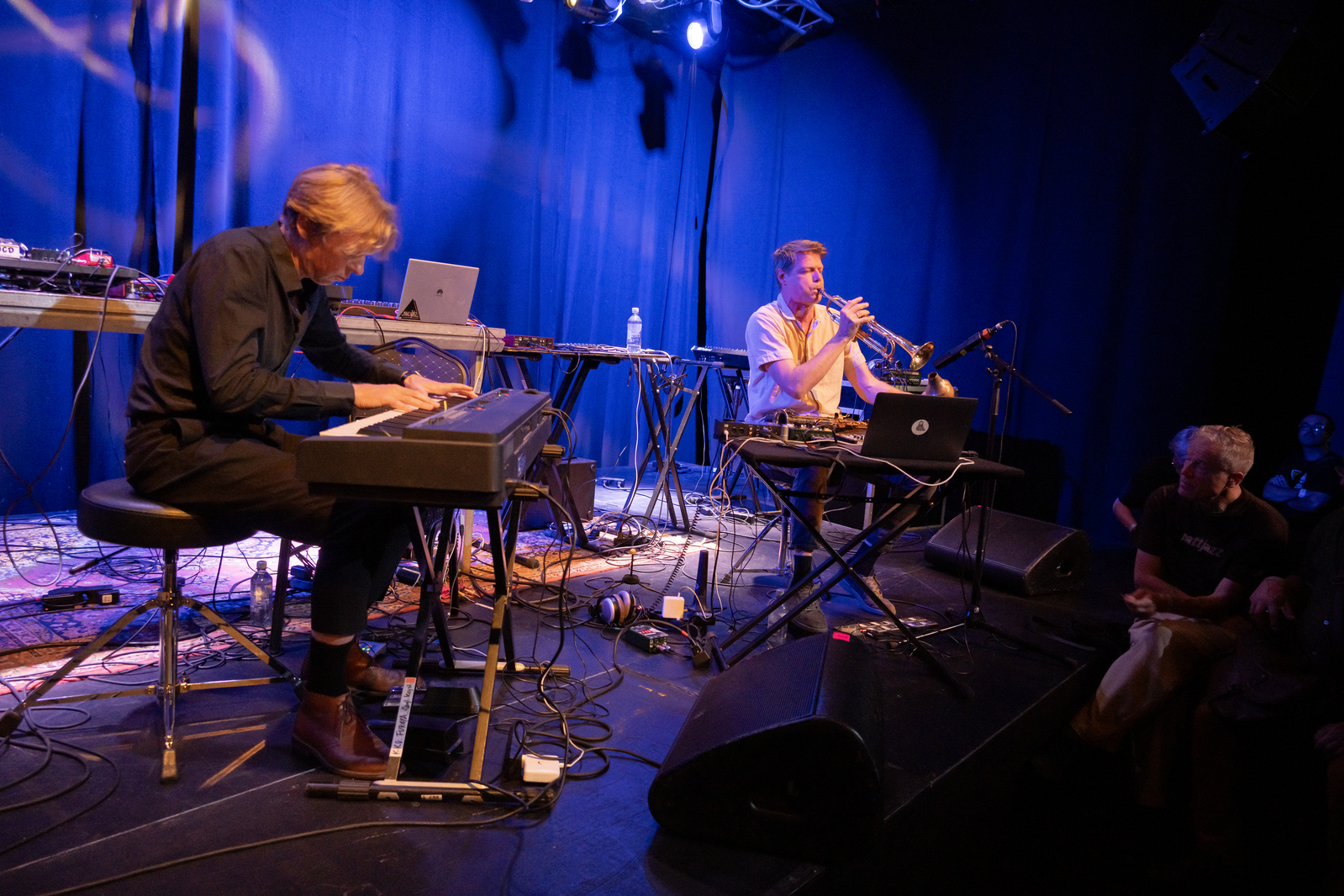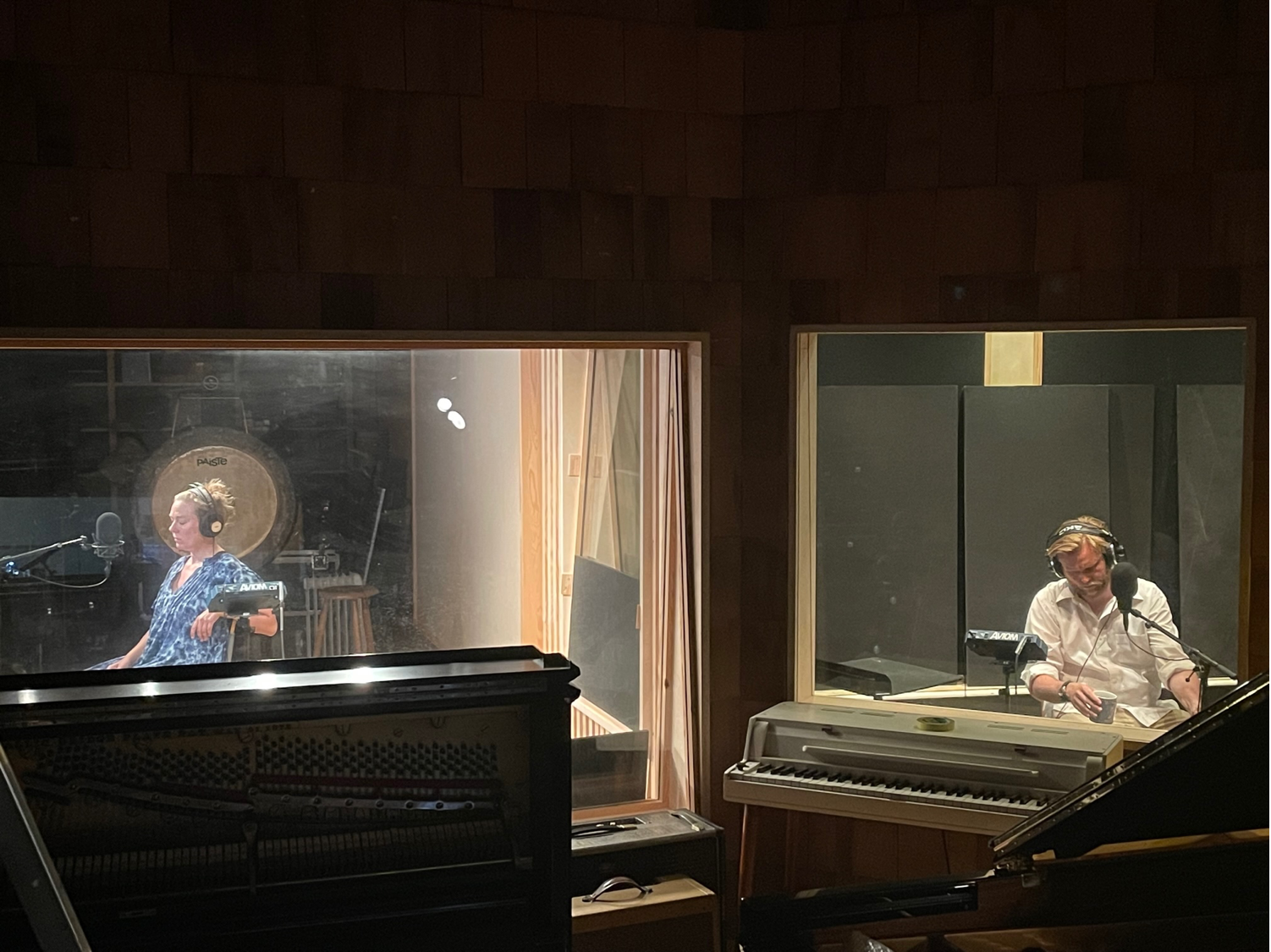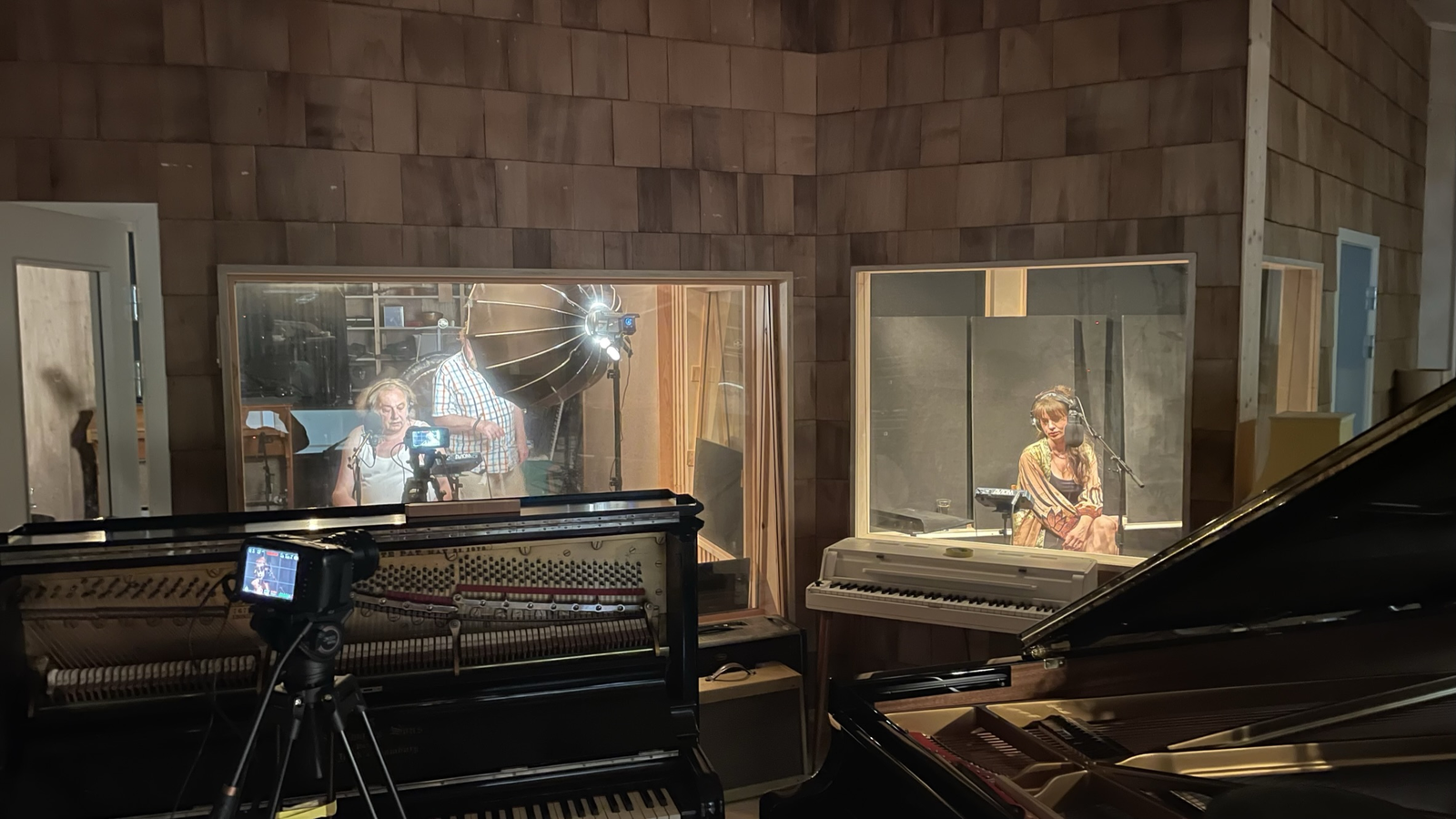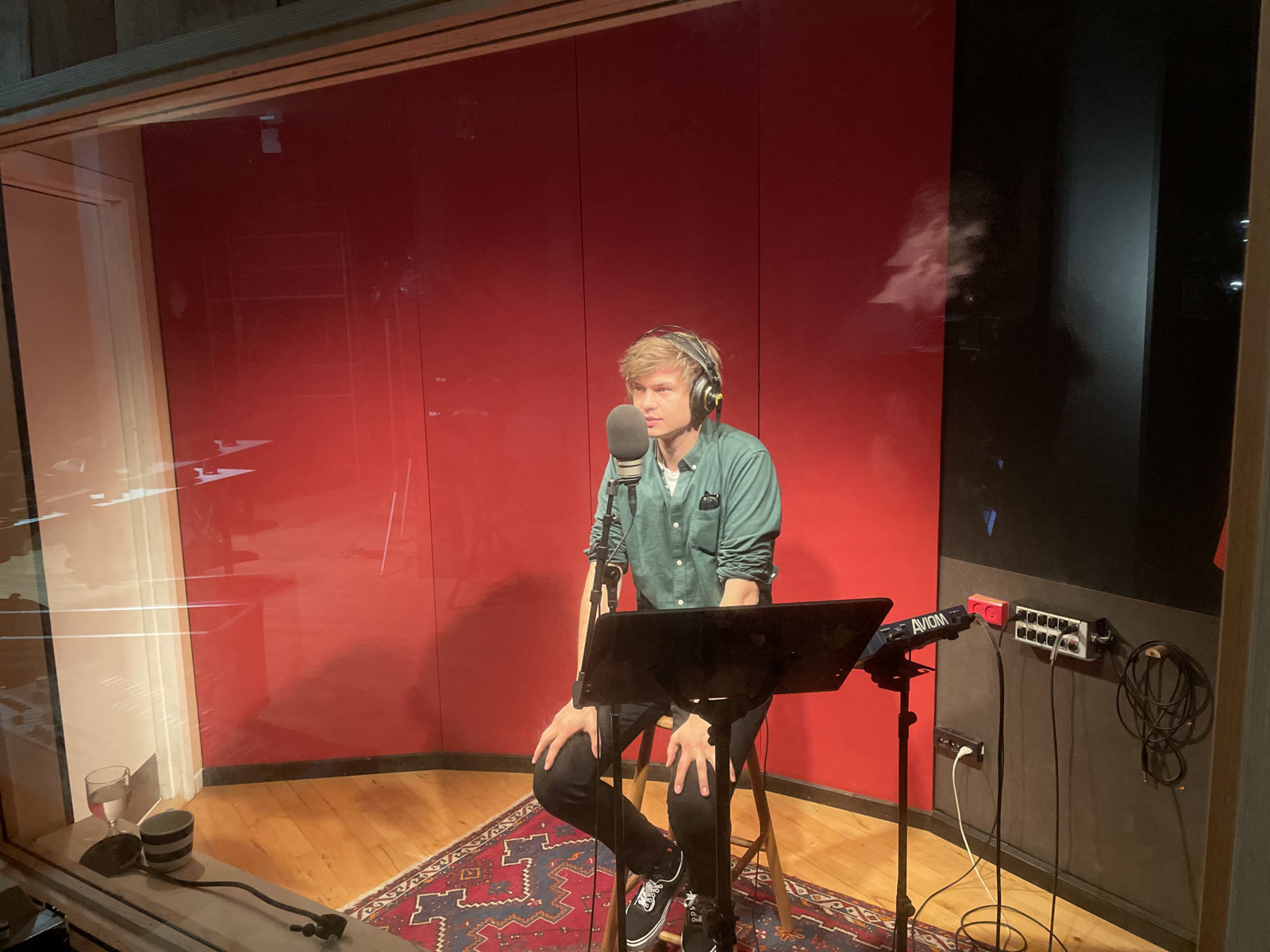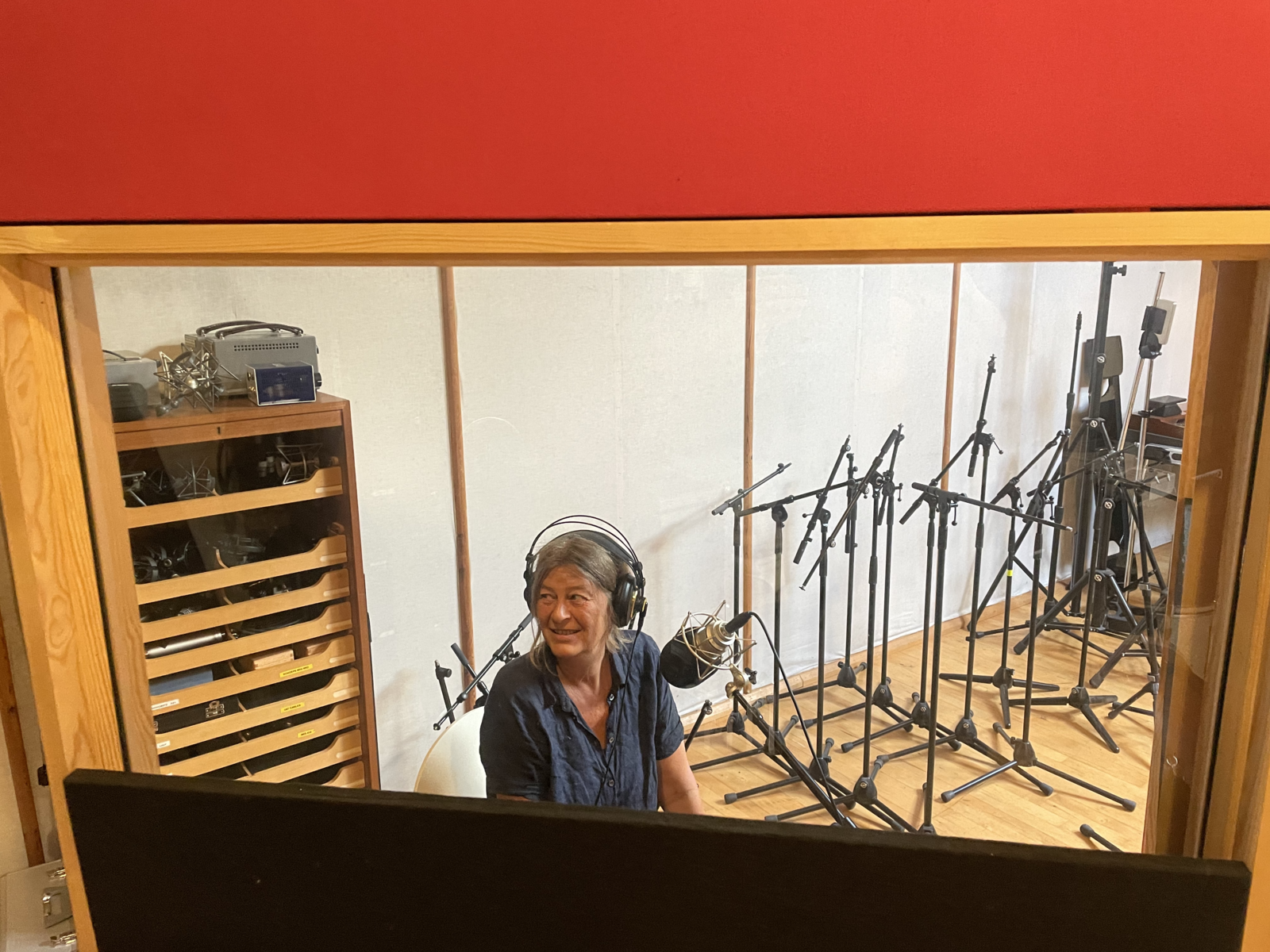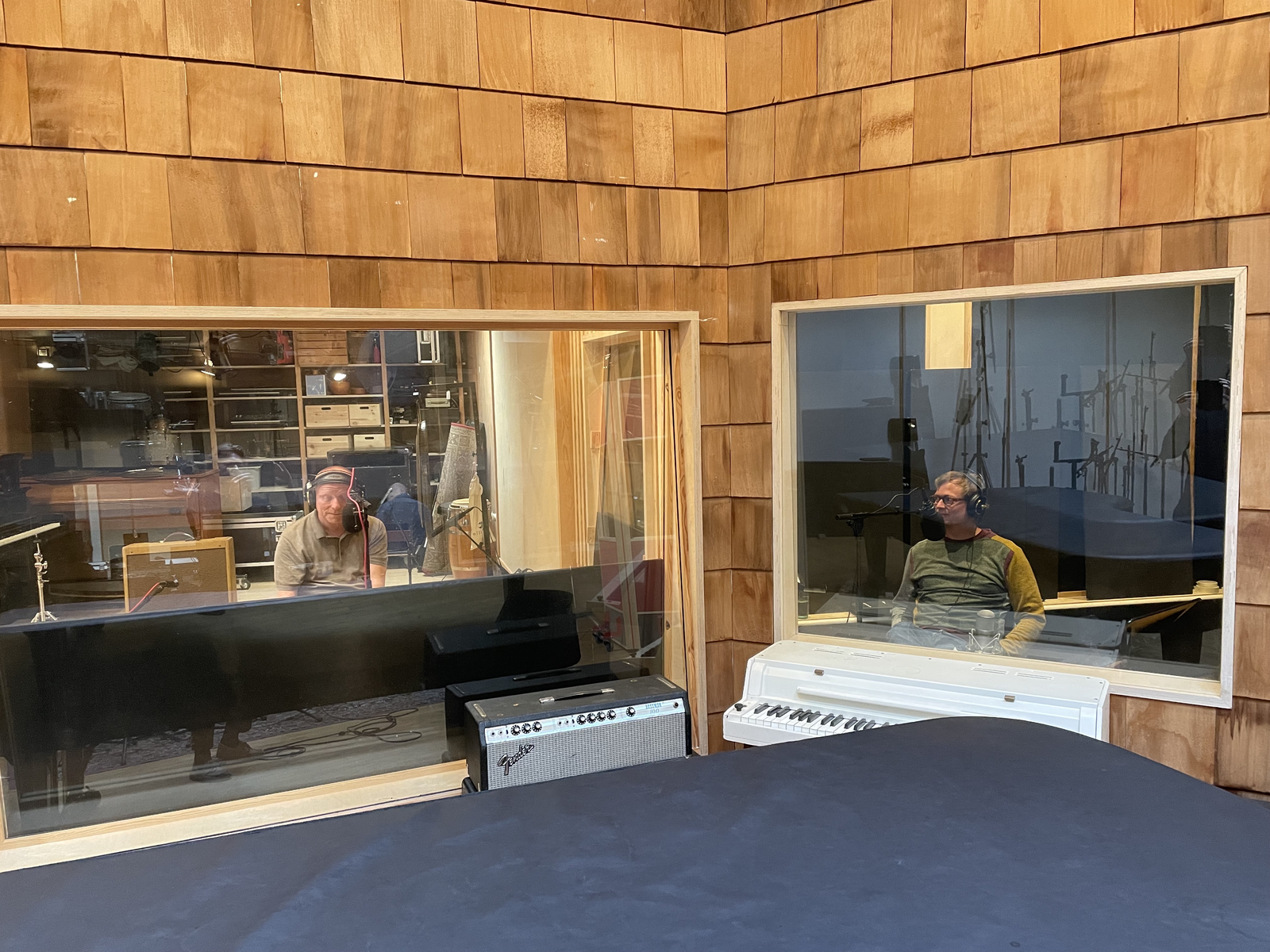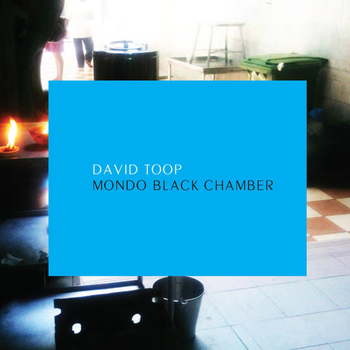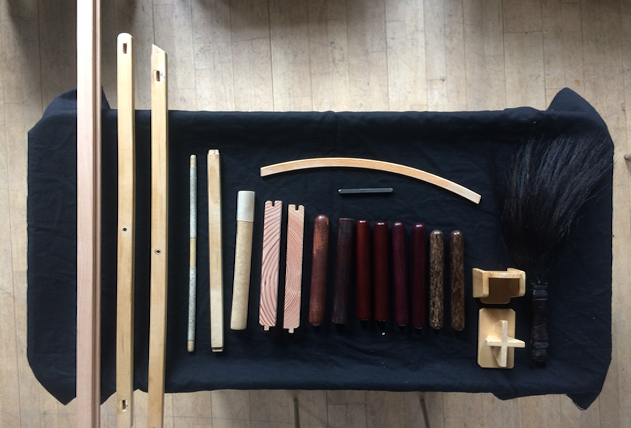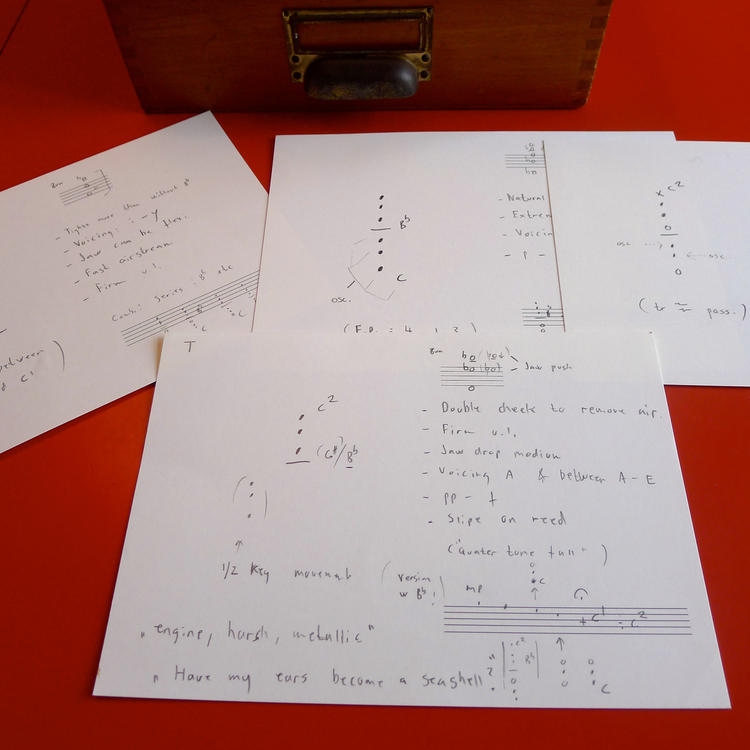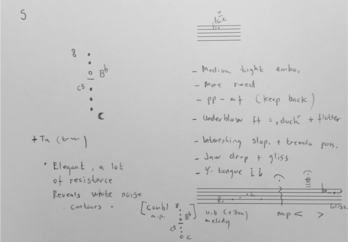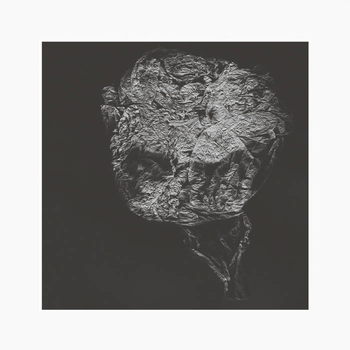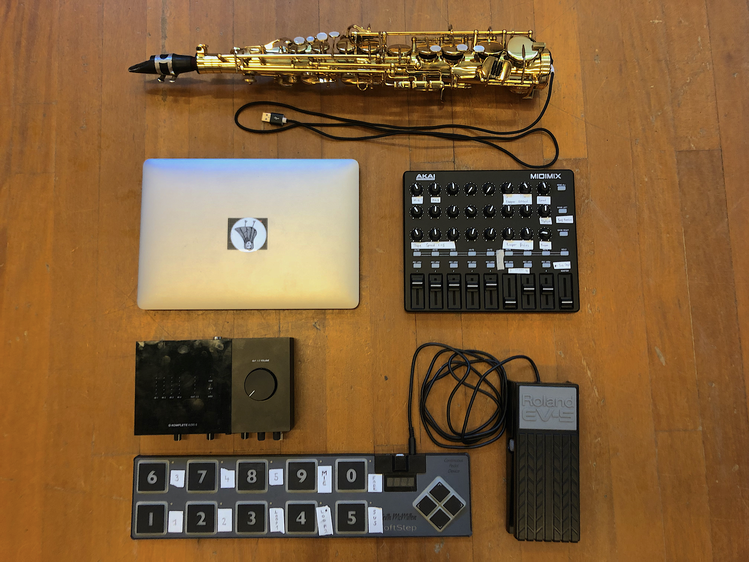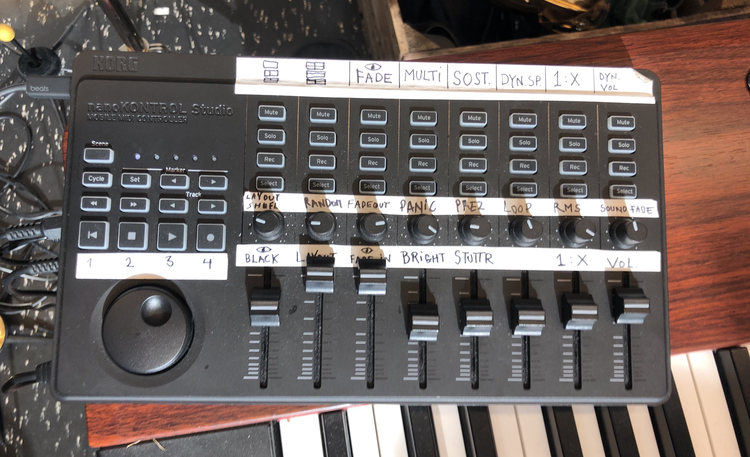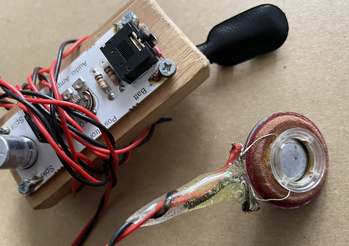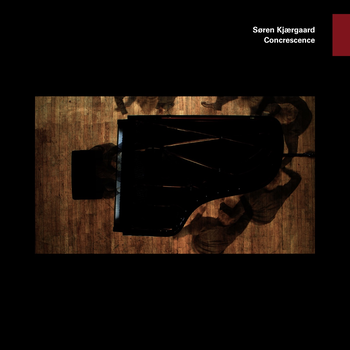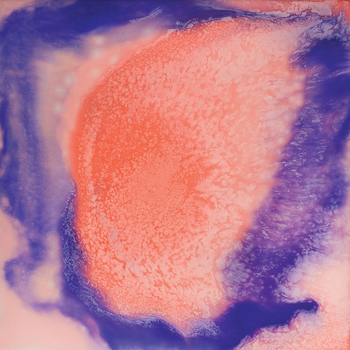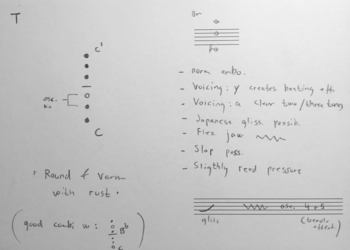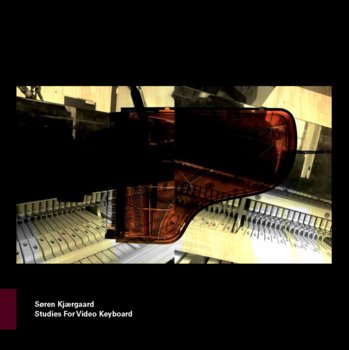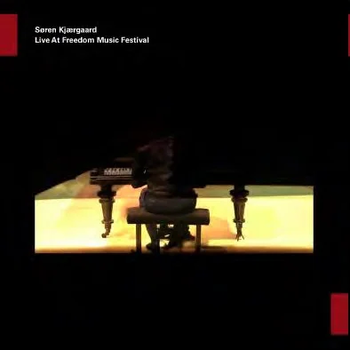Starting out in the vicinity of our duo of saxophone/reed trumpet (Torben Snekkestad) and piano (Søren Kjærgaard), we worked first parallel to one another in order to map out sounds within the sonic territories of each our instrumental practice.
This approach to mapping builds on two previous artistic research projects: 'Multilayeredness in Solo Performance' (Kjærgaard) and 'The Poetics Of A Multiphonic Landscape' (Snekkestad), in which we investigated our individual solo performance practices. Neither synchronized nor intended to become a backdrop for 'Traversing Sonic Territories', both projects would turn out to serve as important grounds for further elaboration.
Embarking from the audio-visual explorations of the so-called video keyboard developed in 'Multilayeredness in Solo Performance', this process involves a continuation of mapping the topographies of practice and play. The mapping encompasses the various sounds, sonic locations, techniques, materials, objects, along with an attempt to (re)name playing approaches in a range of "works" as alternatives to conventional terminologies.
Exploring the piano as a sonic field of latitudes and longitudes, pitch horizons (keyboard, strings) and mechanical gravities (keys, hammers, pedals).
Mapping lines of orientation, lines of motion, in order to open up a multidirectional awareness of play.
Mapping also different of practice approaches: stickworks, footworks, fieldworks, fireworks, etc.
Working with these "works" across a range of parameters and properties, as to the timbres, textures, timings, gestures, dynamics, registers, forms and space of play.
In The Poetics of a Multiphonic Landscape, the work gravitated around an archive box consisting of cards that mix up music notation with technical and poetic descriptions of the mapped sounds. Snekkestad explains:
The box acts as something between a notebook and a set of etudes. Made to make sense to me, not to anybody else, it could include anything from subjective notions on physical characteristics (acoustics), how they might be perceived (psychoacoustics), their function and meaning (semiotics and semantics), or their emotional/affective qualities (aesthetics). (...) It represents a deep part of my artistic practice and explicitly is:
1) a collection of working notes (a practice diary).
2) a place for generating inspiration.
3) a location for a personally inscribed practice.
4) private, at the moment (closed).
Shifting from mapping to sampling. Zooming in and out between the overall map, its sonic regions and areas of the practice, and with a more detailed attention: the singular sounds, sonic gestures and other idiosyncrasies.
Sampling also as in testing, trying out: this sound, that movement. A register of capacities. Sampling sonic variations, building up registers, covering regions, still aware of the limitations of mapping and sampling as well as of the measurement and recording of (a) sound: of never quite covering its full range, along with the unclear boundaries between sound, instrument, practice, and the contingencies of play.
And in maintaining awareness of this, trying to sample within a set of limitations:
1) Only the acoustic sounds of each of the duo’s musicians are sampled;
2) The acoustic sounds are recorded without applied electronic manipulation or post production, so as to draw up a basic sonic territory.
And here we draw upon Torben Ulrich's notion of basic "in the sense of being “prior” to a more finely articulated performance repertoire; basic in the sense of being a kind of distillation, drawn from already experienced practices, still, basically open to a range of possibilities, exacting as well as playfully untried." [1]
Thus, also hearing the sampled sounds in their limitless virtual potential, their capacity to transform and re-enact in every encounter.
Sonifying the maps, recording and mapping anew in the growing archives of the sample libraries.
Expanding sonic territories, still within the vicinity of the duo, to also include published solo works (see above). A cutting into content never intended for sampling, and as such, re-contextualizing (past) events that weave other qualities and sonic temperaments into the mapping.
The sample libraries now consisting of an expanding range of sonic aspects including, but not limited to:
[1] Ulrich, Torben, Martin, Molly, New, Rick (2002). Before the Wall: Body & Being. Torben Ulrich: writings: Etc. (visited 2023)
Taking steps into a more collaborative setting, giving more nuance to the traversive interplay, or in closer proximity, intraplays of the sonic territories. Sharing, at first, within the duo, exchanging sample libraries and trying our way also with embedding and embodying each other's materials, carefully, playfully, and of course, technologically into our transformed playing situation(s).
Then, in further iterations of sharing, inviting new voices into the process, expanding the sonic territories. Employing new sonic topographies, materialities and technologies into the field of play.
Materials now also including various kinds of paper, cardboard, bamboo, flute, reel-to-reel tape, cassettes, bone conduction mics etc.
A sharing not only of sounds, but also of (underlying) approaches ...
Passing also the samples libraries further on to sonic practitioners not necessarily related to this project, without any requirement to return or exchange materials. A trans/action of samples intented to traverse beyond the territories of our project, leaving behind ownership of the samples, letting them act on their own in their encounters with others.
Embedding the exchanged samples libraries by means of digital code and MIDI (Musical Instrument Digital Interface), enabling play across multiple sets that combine different registers of the sample libraries.
Writing codes, testing options in search of digital instrument set up, that are within mechanical proximity of our conventional instruments. Yet, also b(l)ending the sampled acoustic sounds into an electro-acoustic field of play, that disrupts the acoustic logics of the conventional instruments' architecture.
Programmer and project collaborater, Gianluca Elia, elaborates:
The tool I chose to program software for TST is SuperCollider, a programming language/platform for computer music. The main tradeoff inherent to this choice is that, while languages like C++ would yield a more robust and reliable final product, SuperCollider is more suitable for continuous prototyping and on-the-fly adjustments, which were crucial to this specific process. Developing for TST meant a constant dialogue with the practitioners, to tailor the software to their needs and desires as they developed through the period, with its crucial points at in-person tryouts, when it was required to adjust both details (like parameters) and structure (adding/removing features), even just to have them try how they would feel on the spot. On the other hand, compared to graphical solutions, or even to solutions that don't require programming at all, working with code provides powerful ways of keeping track of progress during long development cycles (e.g. version control software, but also programming paradigms as means to structure functionalities).
A technological process not only embedded into one's own situation, but shared in a global community. Gianluca continues:
SuperCollider is open source, meaning that it is developed voluntarily by a global community of practitioners, and it is accessible with no licensing costs. Since the beginning of this research process, every time I encountered something that didn't work in SuperCollider itself, or something that I could improve, I had the occasion to contribute my work to the community, expanding the scope of my work from only benefiting this specific research to helping a global community of practitioners of different natures.
Embedding also the shared samples into other technologies and sonic practices. For instance, transferring them onto to different kinds of tape: cassette tape, reel to reel tape, re-turning the sounds toward other compostures.
In the practice of David Toop, to sonify the samples in different materialities (paper, skin, bamboo, ballons), signalled through a bone conduction mic.
Situating the playing in a renewed performance practice. An (ex)change of settings. Embodying play(fully) within new technological conditions, calling for another kind of response-ability.
Only but a limited reliability as to one's habitual ways of navigating the (acoustic) instrument. Calling for a different orientation. The sample libraries now to be approached as dynamic, virtual maps that awaits circuitry. A play of new co-ordinates and coordinations: bodily, instrumentally, topographically.
Notions of polyphonicity as practiced on the acoustic piano and saxophone, also unfolds in a polychronicity, where tonalities and timings, temperaments and temporalities converge in re-contextualixed trans/formations.
The above track is a live duo recording of the very first time we performed by playing on each other's samples. The process leading up to this event, along with the performative moments occuring before this passage of music goes as follows:
After the first covid-lockdown in Denmark (July 2020), still caught up in a sort of linear orientation through the methodological stages, we were (finally) able to meet up in a performative setting. A few weeks before the concert, we exchanged the sample libraries, so that each of us could get to know the other’s samples and arrange them on one's own digital set up. We did not meet up to practice together, as we wanted to experience that first meeting as improvisers in a performative setting together with a live audience. We started out acoustically, at “home” on our “own” instruments, so to speak, and about half way through the concert, we shifted to the samplers. We didn’t agree on when this would happen, but left it open to the contingency of play.
The sudden collisioning of sounds that occurred, when we shifted to the digital set ups, opened a different sense of listening and dis/orientation in the unfolding sonic territories and gave a first hint of how these experiments could bring us toward a point where authorship and instrumental conventionality would start to destabilize and potentially dissolve.
Listening critically, carefully. Drawing Karen Barad's a notion of critically, that is response-able, contingent and relational.
The method of critical listening relates to a way for musicians to engage in a listening after playing, that is at the same time performative. Described in simple turns, the practice goes as follows: after having performed and recorded, we sit, each by ourselves and listen (back) to what we just recorded. Separately, yet simultanously listening. Each with a microphone in front of us, having the opportunity to speak out what comes to mind during the listening session. This is followed by a collective listening to the music along with the recorded verbalizations. A polyphony and polychronicity of voices, words and sounds, that unfold yet other (con)textures of the sonic territories.
A listening process itself that e/merges the entangled states between memory of play and the moment in play. Listening to what happened and has (yet) to (be)come.
The ambiguity we experience conveys the suspended state of playing across these sonic territories. However, having performed the music, it is evident that we are also entwined in the events that unfolded, caught up in what had happened. Our listening mostly reflecting (back) on passed events, wondering about who did what, still trying to navigate between sonic identities.
This brought us to expand the format toward participants
Listening session with Naya Burić and Zlatko Burić. Music by David Toop, Søren Kjærgaard and Torben Snekkestad.
Expanding formats
This brought us to inviting other participants into the listening process. Participants that were not having any ties to the music. Inviting musicians and composers as well as people coming from other fields and disciplines: engineering, visual arts, musicology, film, theatre, radio etc.
Experimenting with further iterations of the practice. Trying also to let the group of listeners be able to hear each other during the listening session.
Opening up the play and listening-space. A play of listening, playing with listening. Picking up threads from each other, entangling lines, intra-playfully, response-ably, diffractively.
Further iterations: Superposing different listening takes of the same music. Entangling further the voices, heard, played.
Iterations of practice, developing toward a diffractive methodology. Here in the voicing of Karen Barad:
I call a diffractive methodology, a method of diffractively reading insights through one another, building new insights, and attentively and carefully reading for differences that matter in their fine details, together with the recognition that there intrinsic to this analysis is an ethics that is not predicated on externality but rather entanglement. Diffractive readings bring inventive provocations; they are good to think with. They are respectful, detailed, ethical engagements. [1]
Suggesting here a small change, in order to situate the practice in a sonic domain. Calling it, still in resonance with Karen Barad's voicing, "a method of diffractively listening for insights through one another, building new insights, and attentively and carefully listening for differences that matter in their fine details." And in continuation, stating that "Diffractive listening bring inventive provocations; they are good to think with. They are respectful, detailed, ethical engagements.
Transcribing the listening sessions as further iterations of mapping, sampling, sharing and so on. The texts become silent documentation of the listening, yet giving voice to what's heard, carrying with them a polyphonic poetics of their own. In this way, they provide a semantic mapping of the listening experience, conveying a sonic agency that transports the original recordings into other aesthetic territories. Bringing us (also) back again to Karen Barad's notion of "reading insights through one another", where the reading of these texts as part of our practice offers inventive provocations, opening up sonic and imaginary spaces.
Listeners not being concerned with how it went, how one performed, but with what is sounding here and now. A listening and responding that bypasses (self) critique of what happened, and engages playfully with what is happening.
Transcription of a listening session with Henriette Groth, Niels Lyhe Løkkegaard and Tanja Schlander. The piece was subsequently entitled “Soft beating, small ladder”, released on the album 'Traversing Sonic Territories´.
A collection of sounds now revisited, the box reopenened, in order to widen the multiphonic landscapes toward a broader saxophonic and sonic terrain.
Mapping and (re)naming various aspects of the practice in a range of "works", that explore different instrumental, bodily and sonic approaches, also linking up with the terminology proposed in Kjærgaard's practice, even if mapped differently.
This way of ascribing the different modalities of the practice to a register of "works", points to an overall attempt in the project to employ a terminology that is both concrete and open, granting the possibility of transposing approaches between instruments, settings, sounds, players.
First version of Torben Snekkestad's digital set up, where a highly sensitive "intra-mic" is inserted into the body of the acoustic saxophone, picking up pitch signals and breath velocity, assigned to trigger different samples.
This set up resulted in bleeds and blends, between the acoustic pitches played and the samples triggered, thus leaving always audible the saxophone as a sort of a priori reference point in the mix, guiding the samples. In the second version of Snekkestad's set up (right), this (saxophonic) reference point was muted, giving more space to the samples played.
This track is an example of how the samples listed below are played out in a duo improvisation (excerpt from "Of grounds un/folding" released on the duo album 'Cutting Together-Apart')
[1] Rick Dolphijn and Iris van der Tuin (2012). New Materialism: Interviews & Cartographies, Open Humanities Press, University of Michigan Library, Ann Arbor, 2012
Music and listening by David Toop, Søren Kjærgaard, Torben Snekkestad. Music remixed (pre-listening) by Marta Salogni.
David Toop playing with cassette tape signals through a bone conduction mic on different materials during the recording of the track later entitled "Called in", to be found in two versions in this exposition: with listeners and without.
Collective listening session with Carla Zaccagnini,Holger Schulze, Kristian Mondrup, Laura Toxværd, Lotte Anker.
Music by David Toop, Søren Kjærgaard, Torben Snekkestad.
Collective listening session with Carla Zaccagnini, Holger Schulze, Kristian Mondrup, Laura Toxværd, Lotte Anker.
Music by David Toop, Søren Kjærgaard, Torben Snekkestad.
Collective listening session with Carla Zaccagnini, Holger Schulze, Kristian Mondrup, Laura Toxværd, Lotte Anker (listening session a) layered with David Toop, Søren Kjærgaard, Torben Snekkestad (listening session b).
Transcription of a listening session by Toop, Kjærgaard, and Snekkestad. The piece was subsequently entitled “Inconceivable machinery” and released on the album 'Traversing Sonic Territories'.
Transcription of a listening session by Toop, Kjærgaard, and Snekkestad. The piece was subsequently entitled “Inconceivable machinery” and released on the album 'Traversing Sonic Territories'.
Second version of Snekkestad's set up, designed around a digital-only saxophone (EMEO) with breath velocity control and MIDI-controllers onto which the samples are mapped.
A (continuation) of the digital sampler program originally coded for the video-keyboard in Kjærgaard's artistic research project, Multilayeredness in Solo Performance.
Samples embedded on the reel to reel tape machines of producer, Marta Salogni (Zona Studio, London, UK)
Combined transcription of two listening sessions with (a) Carla Zaccagnini, Holger Schulze, Kristian Mondrup, Laura Toxværd and Lotte Anker, and (b) Naya Burić and Zlatko Burić, subsequently mixed into one piece entitled “A melody for me”, released on the album 'Traversing Sonic Territories'.


